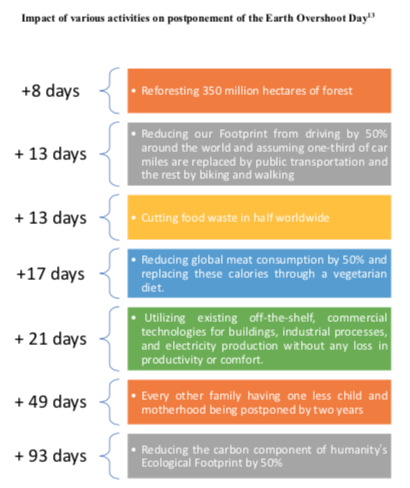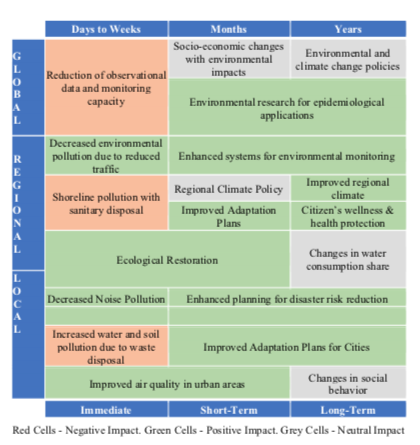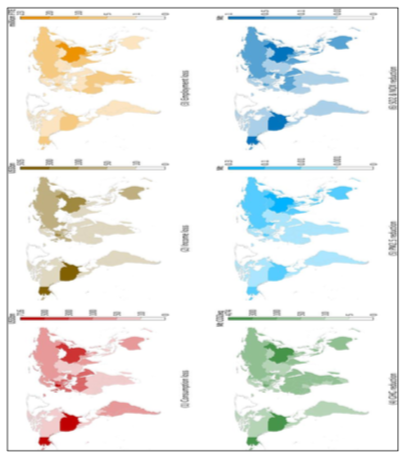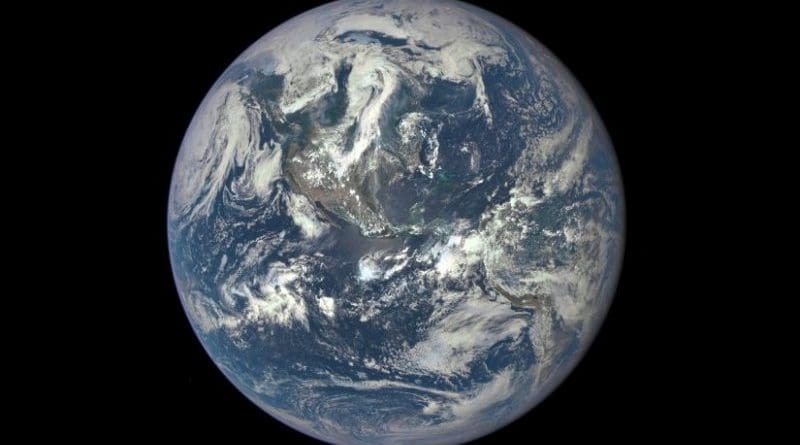Earth Overshoot Day 2020: A Perspective On The Past, The Pandemic And The Future – Analysis
By Nishant Shah and Lavanya Kudli*
Earth Overshoot Day is the day of the year on which humanity’s demand on nature exceeds the Earth’s capacity to regenerate this demand over the course of the entire year1. That date onwards, up till the year ends, the global economy is operating in ‘Ecological Deficit’2. Ideally the Earth Overshoot Day should be 31st December so as to harness the perfect ecological balance, but due the never-ending caprice of humanity, this date is far from ideal in recent times.
The Global Footprint Network (GFN) (Lin, Wambersie, Wackernagel & Hanscom, 2020) calculates this date on the basis of the impact of three factors viz. carbon, food and forests on humanity’s footprint. To calculate the Earth Overshoot Day, one needs to consider the ratio between the Earth’s ability to generate resources – Biocapacity, and humanity’s demands placed upon nature – Ecological Footprint. Both Biocapacity and Ecological Footprint can be tracked and compared against each other, based on two simple principles:
- All the competing demands on productive surfaces, i.e., the surfaces that contain the planet’s biocapacity, can be added up;
- By scaling these areas proportional to their biological productivity, they become commensurable.
This year though, it was declared that the Earth Overshoot Day would fall on August 22nd, as compared to last year’s 29th July. The GFN (Lin, Wambersie, Wackernagel & Hanscom, 2020) claims that the global ecological footprint has fallen by ~9.3% this year.
In fact, Earth Overshoot Day has not been this late in the year since 2005. This apprehensive shift of 3 weeks and 3 days seems minuscule but beholds various components and factors contributing to its postponement. One of the major contributors being the pernicious COVID-19 pandemic, which aptly was promulgated by GFN President Mathis Wackernagel as, “It’s not done by design, it’s done by disaster.” Well, as they say, every cloud has a silver lining, the pandemic too has manifested various avenues for us to venture in order to reduce our burden on the environment and perpetually propelling the date closer to ideality.
Thereby, in this paper we shall be focusing on an in-depth analysis of the causes, effects and causalities of the shift in the Earth Overshoot Day. At the same time, we shall not only be discussing threats to the next overshoot day but also promises for the future. In the light of this momentum, we shall also be bringing forward our perspectives in matters of contributing to this cause at a grass-root level and accomplishing the Sustainable Development Goals laid down by United Nations.
CAUSES, EFFECTS AND FUTURE ENDEAVOURS WITH RESPECT TO THE SHIFT IN THE 3 E’S – ECOLOGY, ECONOMY AND EFFICIENCY
The parallel increase in forest fragmentation and human intervention has enhanced the risk of zoonotic disease transmission due to enhancement of proximity to exotic wildlife interactions. Consequently, COVID-19 pandemic eruption stimulated several requests made to WHO by distinguished conservationists to recognize the effect of the animal-human interaction link. A large quantum of stimuli has to be provided to established conventions like the Washington Convention that recognize the negative impacts of animal trafficking 3.
However, the impositions of various levels of lockdowns around the world led to restoration of the ecological balance to some extent. The unprecedented pandemic situation has caused the first ever delay in the overshoot day since 1970’s 4. Basically, nature has its own ways of finding balance. To sustain and maintain the postponement of the earth overshoot day, major restrictions on the human ecological footprint should be inflicted through manipulations in the three E’s — Ecology, Economy and Efficiency.
Decreased direct interactions with natural bodies through cessation of recreational activities and vehicular mobility has led to cleaner water bodies, restoration of ecosystems, reduced air pollution and reappearance of exotic wildlife species. But such evidences of improvement are threatened by reports of increased poaching activities due to eased restrictions and food insecurity in Asian and African regions 5.
There has been an evident correlation in the environmental impact due to the pandemic-induced economic impact. The economies of the OPEC nations took a hit because of reduced oil extraction and refining activity due to reductions in all modes of transport. Reduced vehicular pollution have assisted in reducing carbon emissions to a large degree. Reductions in GHG emissions occurred all over the globe, but mainly across China and Northern America, and less across Europe’s less emissions- intensive economies.
Reductions of PM 2.5 emissions are expectedly large in China and India, whilst energy- and transport-related SO2 and NOx emissions also fall across the rest of Asia and the Americas6. The GFN (Lin, Wambersie, Wackernagel & Hanscom, 2020) reported that economies like USA and China happen to be the largest carbon footprint contributors and contributed to a major extent towards the postponement of the earth overshoot day. A decrease in their combined footprint contributed to about a total of 17% decrease in the daily global carbon emissions from January to early April.
It should be noted, that this reduction was due to forced conditions and not due to a major global structural change7. Such a realization should be an incentive to incorporate sustainable principles in the economy. Between 70% and 80% of all people are expected to live in urban areas by 2050. Consequently, smart city planning and urban development strategies are instrumental to making sure there is enough natural capital and to avoid excessive human demand that would erode it. Examples include energy-efficient buildings, integrated zoning, compact cities, and effective options for people- powered and public transportation 8.
Further due to a global economic slowdown GFN (Lin, Wambersie, Wackernagel & Hanscom, 2020) noted decreased industrial logging, especially with respect to lumber harvest. This effect is opposed by resource extraction by migrant workers returning back to their rural communities and plummeted conservation efforts in at-risk areas due to mobility restrictions during the current scenario. However, this opposition was not strong enough and the net result remains reduction of forest products footprint by 8.4%.
With an unlikely regain of pre-pandemic economic levels before 2020, there should be an increased effort in rebuilding an economy that is green 9. Rather than providing short term fiscal benefits, a sustained green stimulus needs to be incorporated. Policy making that promotes investments and innovation in the green sector, reduced subsidies on fossil fuels and pricing of carbon and pollution can assist mitigation of climate change 10.
Additionally, GFN (Lin, Wambersie, Wackernagel & Hanscom, 2020) also reported that the food and agricultural footprint remained fairly unchanged because of the several factors that counterweigh the lessened reliance on external food preparation facilities. These include enormous food wastage due to food supply chain disruptions, restrictions on inter-border travel that has left fields unattended and inability of abruptly unemployed people to afford daily meals. Ideal case scenario would be to halve the per capita global food waste at the retail and consumer levels and reduce food losses along production and supply chains, including post-harvest losses, by 2030 11.
The global specialization in food production may lead to efficiencies, but it also can reduce resilience of food systems, particularly for countries that are both net-importing food and have low incomes. These countries are most vulnerable to food shocks. Due to the excessive overuse of the planet’s biological resources, our economies now are limited by the availability of Earth’s biocapacity. We must employ classical conservation, restoration, regenerative agriculture and sustainable fishing in order to boost the health of our ecosystems, and in turn, the planet’s capacity to regenerate biological resources (“Food – Earth Overshoot Day”, 2020).
Globalization incentivized an efficient model mass production and complex supply chain networking both of which took a massive hit in the current scenario. This provides an opportunity for countries and organizations to reconstruct their economic models by incorporating the principles of circular economy in them. To prevent radical consumer behavior such as panic buying, innovative models surrounding shared ownership should be developed. Shortening of supply chains and reliance on local food supply would not only boost the national progress but also allow for security of food and commodity. One major realization during the pandemic has been that wholesomely packaged lifestyles have led to lack of resources prioritization. A necessary step that countries need to adopt is prioritized consumption and thorough realization of resource limitations12.
Factors like historic crude oil prices making virgin plastic cheaper, may cloud implementation of a circular economic model. Decarbonizing the economy can be our best possible chance to address climate change as it would improve the balance between our ecological footprint and our planet’s renewable resources. Over 150 years ago, the carbon footprint of humanity was close to zero. If we want to live up to the commitment of the 2015 Paris Climate Accord, the carbon footprint would have to be zero again by 2050. Reducing the carbon component of humanity’s ecological footprint by 50% would get us from consuming the resources of 1.6 Earths down to 1.1 Earths. This corresponds to moving the date of Overshoot Day by about three months 13.
CONCLUSION
Taking the postponement in a positive light, we must equip ourselves and work towards moving it all the way till 31st December. This ecological momentum should not be taken for granted rather it should be used in achieving our future targets for the safety of our planet. To be sustainable, the development ultimately must also fit within our planet’s resource budget. The problems and the ensuing solutions should align with the UN Sustainable Development Goals (SDGs) 2, 7, 11,12, 14, and 15. Hence by catering to these aforementioned goals and affirmatively working in a direction where these goals are effectively achieved, would therefore result in a significant postponement of the date of Earth Overshoot Day. It is high time we prioritize environmental conservation independent of age, race, geography, creed, gender, nationality etc. We must come together and strive for a world order where we consume resources equivalent to less than 1 Earth!
*About the authors:
- Nishant Shah, Department of Dyestuff and Intermediate Technology, Institute of Chemical Technology, Mumbai, India, [email protected]
- Lavanya Kudli, Department of Dyestuff and Intermediate Technology, Institute of Chemical Technology, Mumbai, India, [email protected]
Impact of various activities on postponement of the Earth Overshoot Day13

Observed and Potential Impacts of COVID-19 on the environment & climate change 14

Global impacts from the COVID-19 pandemic broken down by world region 15

REFERENCES
- Lin, D., Wambersie, L., Wackernagel, M., & Hanscom, P. (2020). Calculating Earth Overshoot Day 2020 [Ebook]. Global Footprint Network. Retrieved from https://www.overshootday.org/content/uploads/2020/06/Earth-Overshoot-Day-2020-Calculation-Research-Report.pdf
- Oliphant, V. (2020). Earth Overshoot Day 2020: How is Overshoot Day calculated? What was date in 2019?. Retrieved 20 September 2020, from https://www.express.co.uk/news/science/1326072/Earth-Overshoot-Day-2020-what-is-how-Overshoot-Day-calculated-date-2019
- Cheval, S., Mihai Adamescu, C., Georgiadis, T., Herrnegger, M., Piticar, A., & Legates, D. (2020). Observed and Potential Impacts of the COVID-19 Pandemic on the Environment. International Journal Of Environmental Research And Public Health, 17(11), 4140. doi: 10.3390/ijerph17114140
- With Three-Week Delay, COVID-19 Leads to Greatest Ever Single-year Shift in Earth Overshoot Day in 2020 | The Weather Channel. (2020). Retrieved 20 September 2020, from https://weather.com/en-IN/india/environment/news/2020-08-28-covid-19-greatest-ever-single-year-shift-earth-overshoot-day-2020
- GHOSAL, A., & CASEY, M. (2020). Yahoo is now a part of Verizon Media. Retrieved 20 September 2020, from https://news.yahoo.com/coronavirus-lockdowns-increase-poaching-asia-042703906.html
- Lenzen, M., Li, M., Malik, A., Pomponi, F., Sun, Y., & Wiedmann, T. et al. (2020). Global socio-economic losses and environmental gains from the Coronavirus pandemic. PLOS ONE, 15(7), e0235654. doi: 10.1371/journal.pone.0235654
- Porterfield, C. (2020). Good News: Global CO2 Emissions Plummet During Covid-19 Lockdowns. But For How Long?. Retrieved 20 September 2020, from https://www.forbes.com/sites/carlieporterfield/2020/05/19/good-news-global-co2-emissions-plummet-during-covid-19-lockdowns-but-for-how-long/#5d205f7c72b6
- Cities – Earth Overshoot Day. (2020). Retrieved 21 September 2020, from https://www.overshootday.org/solutions/cities/
- Stiglitz, J. (2020). Invest in the green economy and we’ll recover from the Covid-19 crisis | Joseph Stiglitz. Retrieved 21 September 2020, from https://www.theguardian.com/business/2020/jul/02/invest-in-the-green-economy-and-well-recover-from-the-covid-19-crisis
- Barbier, E. (2020). Greening the Post-pandemic Recovery in the G20. Environmental And Resource Economics, 76(4), 685-703. doi: 10.1007/s10640-020-00437- W
- Food – Earth Overshoot Day. (2020). Retrieved 21 September 2020, from https://www.overshootday.org/solutions/food/
- Wijayasundara, M. (2020). Opportunities for a circular economy post COVID-19. Retrieved 20 September 2020, from https://www.weforum.org/agenda/2020/06/opportunities-circular-economy-post-covid-19/
- Global Footprint Network and Schneider Electric. (2020). Strategies for one-planet prosperity [Ebook]. Retrieved from https://download.schneider-electric.com/files p_enDocType=White+Paper&p_File_Name=Earth+Overshoot+Day+-+Final.pdf&p_Doc_Ref=earth_overshoot_day
- Solutions – Earth Overshoot Day. (2020). Retrieved 21 September 2020, from https://www.overshootday.org/solutions/
- doi: 10.1371/journal.pone.0235654.g001

